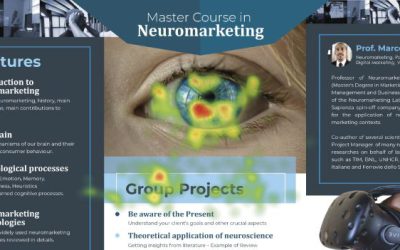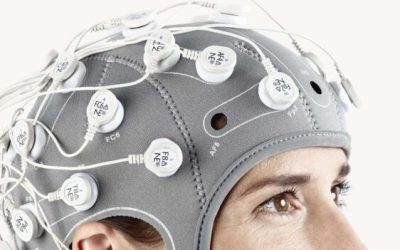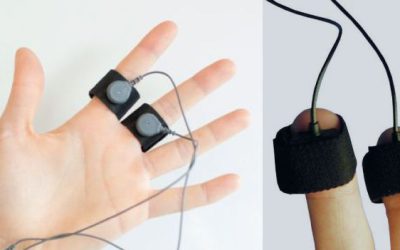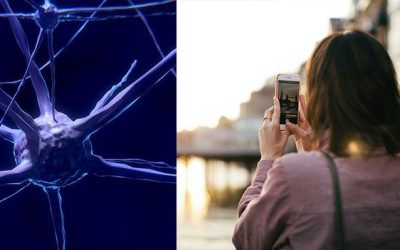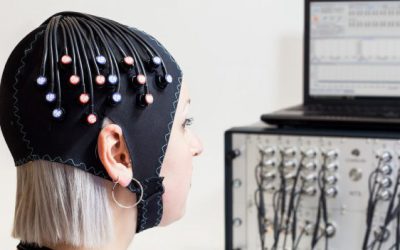The eye tracker is a device that allows the researcher to study the eye movements of people while observing a stimulus of interest, obtaining valuable insights related to the attention processes.
The eye tracking technique is widely used in Neuromarketing studies as it is very easy to integrate with other techniques such as Electroencephalography (EEG), Electrocardiography (ECG), Plethysmography (PPG) detection of the galvanic response of the skin (GSR) and Facial Coding and as it allows to interpret all the results obtained by other techniques in the light of what the experimental subject is actually observing at each specific moment.
The study of attention through the eye tracker is carried out today in different research contexts such as advertising, digital and customer experience. For example, we can study the level of attention generated by the brand within a television advertisement, from the “shopping cart” icon within a website or application, or simply check if our product on the shelf is seen from consumers.
Stationary or Fixed Eye Tracker – Neuromarketing
![]()
Credits – TobiiPro
Stationary eye trackers, also known as fixed or screen-based, are the most commonly used devices to date and are generally placed under the screen used to deliver stimuli (e.g. images, videos and / or websites navigable via desktop).
These devices can therefore be placed either under an external screen or under the screen of a laptop. In general, it is very advantageous to work with two screens in order to use one screen for administering the stimuli (screen visible to the experimental subject) and the other to allow the experimenter to observe the eye movements of the users in real time.
Through the use of ad hoc devices, such as Tobii’s “Mobile Device Stand“, it is also possible to use the fixed eye trackers to study the gazes of users while they interact with an application or website from their smartphone or tablet.
Glasses or Mobile Eye Tracker – Neuromarketing
![]()
Credits – TobiiPro
The mobile eye trackers, also known as “glasses“, over the years look more and more like simple glasses and are mainly used in Neuromarketing in studies that involve the exploration of visual attention in supermarkets or points of sale.
For example, if our goal is to understand if our product on the shelf generates more attention than a product of our competitor, “glasses” certainly represent the alternative to use. Today most of the mobile eye trackers on the market are able to transfer data to the acquisition computer via bluetooth or other wireless solutions, guaranteeing great freedom of movement for the user.
In some cases it may be advantageous to use mobile eye trackers even in studies that involve testing websites and applications designed for smartphones and tablets.
Eye Tracker for Virtual Reality (VR) – Neuromarketing
![]()
Credits – Vive
With the growth of the virtual reality sector, since 2018 the market for eye tracker devices has expanded its offer by showing the first virtual reality (VR) headsets with integrated eye tracker device.
This is a real revolution for the sector, as the virtual reality experience can now be guided by the gaze of users, introducing new ways of interaction and control and increasing the perception of immersion to levels never seen before.
As for Neuromarketing applications, the use of the integration of the eye tracker in virtual reality becomes an indispensable requirement in contexts where the goal is to test new store layouts and / or create experimental protocols in which the variables require a high level of control.
Eye Tracker via Webcam – Neuromarketing
![]()
In recent years, particularly with the outbreak of the covid-19 pandemic, we have witnessed an exponential growth of solutions that involve eye tracking of users via webcam, especially when viewing images and videos.
Although these solutions represent the future, as they allow eye tracking tests to be carried out anywhere in the world, just like traditional marketing research conducted through online surveys, not all solutions on the market guarantee high standards.
Eye tracking, relying on different hardware for each user and in some cases of low quality, very often tends to be inaccurate. The suggestion is therefore to test the different remote solutions available on the market to verify if these are actually compatible with the standards required by the specific research context, before conducting actual studies.
Eye Tracking Data and Metrics – Neuromarketing
From the analysis of the eye tracking recordings it is possible to obtain indicators relating to fixations, saccades, pupil diameter and ocular blinks.
However, the most used metrics in Neuromarketing are mainly related to fixations, in particular:
- Fixation Count (FC)
- Eyeball Count (EC)
- Time To First Fixation (TTFF)
- First Fixation Duration (FFD)
- Total Visit Duration (TVD)
- Average Visit Duration (AVD)
- Revisits
The knowledge of the metrics mentioned, together with some effective ways of representing the data (heat map, gaze plot, gaze opacity) and the ability to identify the type of eye tracker that best suits a specific experimental context, allows experts to obtain extremely relevant information, not obtainable through traditional marketing research techniques.





